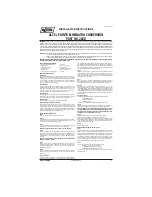
DIAGNOSTIC TROUBLE CODE CHECK PROCEDURE
Diagnostic Trouble
Code Check (Make a
note of and then clear)
Confirmation
of Symptoms
Diagnostic Trouble
Code Check
Problem Condition
Diagnostic Trouble
Code Display
Problem symptoms
exist
Same diagnostic
trouble code is
displayed
Problem is still occurring in the diagnostic
circuit
Normal code is
displayed
The problem is still occurring in a place
other than in the diagnostic circuit
(The diagnostic trouble code displayed
first is either for a past problem or it is a
secondary problem)
No problem
symptoms exist
The problem occurred in the diagnostic
circuit in the past
Normal Code Display
Problem symptoms
exist
Normal code is
displayed
The problem is still occurring in a place
other than in the diagnostic circuit
No problem
symptoms exist
Normal code is
displayed
The problem occurred in a place other
than in the diagnostic circuit in the past
-
INTRODUCTION
HOW TO TROUBLESHOOT ECU CONTROLLED
SYSTEMS
IN-25
25
Author:
Date:
2005 LEXUS IS300 (RM1140U)
In diagnostic trouble code check, it is very important to determine whether the problem indicated by the diag-
nostic trouble code is still occurring or occurred in the past but returned to normal at present. In addition,
it must be checked in the problem symptom check whether the malfunction indicated by the diagnostic
trouble code is directly related to the problem symptom or not. For this reason, the diagnostic trouble codes
should be checked before and after the symptom confirmation to determine the current conditions, as shown
in the table below. If this is not done, it may, depending on the case, result in unnecessary troubleshooting
for normally operating systems, thus making it more difficult to locate the problem, or in repairs not pertinent
to the problem. Therefore, always follow the procedure in correct order and perform the diagnostic trouble
code check.
















































